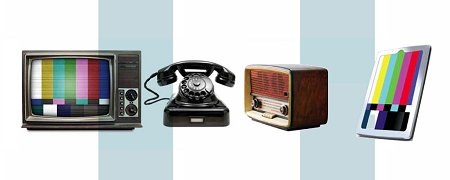
The introduction of television to Australia involved predominantly newspaper owning applicants competing for the licenses. Television was anticipated to be in direct competition with the newspaper audience and the soliciting of advertisements, therefore the powerful media moguls were keen to have a part of the action.
In the process, all successful applicants for Australia’s first TV stations went to newspaper publishers.
Four commercial licenses were granted for the initial stations opening in 1956, two each for Sydney and Melbourne.
- TCN Channel 9 in Sydney, was issued to a company named Television Corporation Ltd, headed by the owner of The Daily Telegraph, Frank Packer.
- ATN Channel 7, was issued to a company named Amalgamated Television Services, a subsidiary of Fairfax, which owned the Sydney Morning Herald.
- GTV Channel 9 in Melbourne was first licensed to the General Television Corporation Limited, a consortium which included two newspapers, The Argus and The Age.
- HSV Channel 7 in Melbourne was originally owned by The Herald and Weekly Times Ltd, owners of The Herald and The Sun.
More licenses were issued later for the less populated states, resulting in further commercial stations opening in 1959.
- QTQ Channel 9 in Brisbane was licensed to Fairfax.
- BTQ Channel 7 in Brisbane went to Queensland Press, owned by the Herald group.
- NWS Channel 9 in Adelaide was owned by Rupert Murdoch, who also owned The News newspaper.
- ADS Channel 7 was launched by Adelaide Television Broadcasters Limited, which was owned by the Advertiser Newspapers, then controlled by The Herald and Weekly Times.
- West Australian newspapers formed a company which was the successful applicant for the license of TVW Channel 7 in Perth, the first television station in WA.
It has taken 50 years for the status quo to change, thereby opening up the means for all to participate in the creation and dissemination of information and entertainment. Now as a result of vast technological advancements and dramatic cost reductions, the ordinary person has available affordable tools to self publish in so many ways. A domestic video camera with hard drive can record broadcast quality moving pictures with stereo sound. Personal computers can be used to professionally edit videos. Musicians can now produce quality music in their garage. People can now publish their novels in eBook form and sell them through Amazon or the iBookstore.
Not only that, but there has been a quantum leap in the relationship between content provider and content consumer. The new breed of tech savvy entrepreneurs employ clever math that measure user habits to build their advertising model. Targeting potential buyers in a more sophisticated manner than any television rating scheme. TV ratings usually measure how many sets are tuned in and not the level of participation. The internet data collection goes well beyond that, often taking it to a very personal and intimate level.
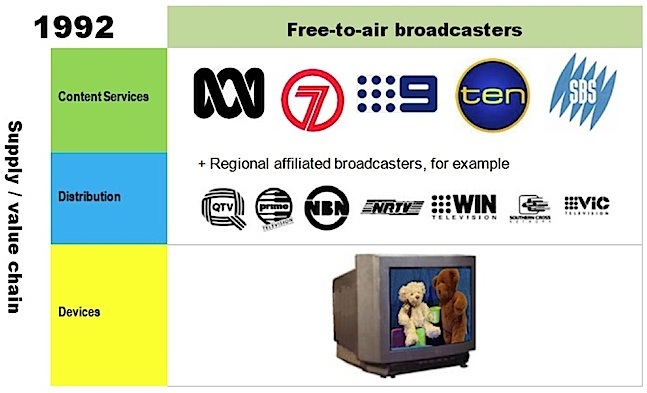
Traditional television and particularly print technology is constrained by its more static nature. Much has evolved in the last 50 years. The dynamic nature of the web enables both real time happenings and full user interactivity. Its a two way street with email, forums, live chat with photo and video sharing. All manner of user generated content can also be put out there to a global audience.
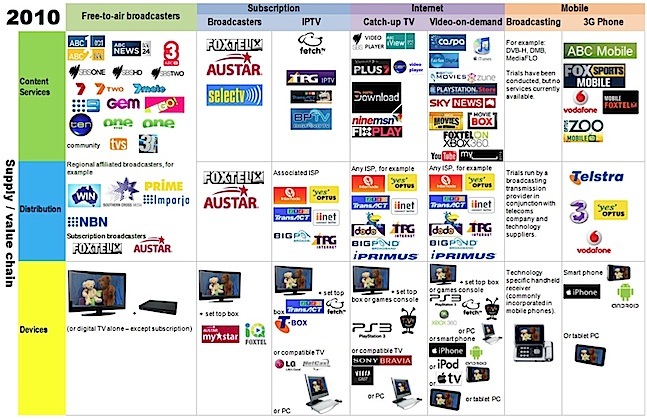
The Internet revolution has brought with it a greater convergence of moving images, still photography, animated graphics and music, with talk and text all being a part.
There has developed a constant flow of clever software and games, which is creating new markets, much of it in the form of Apps. There’s also the hardware innovations such as the iPhone and iPad that often combine a mobile phone with computing power, a still and video camera, a multimedia centre and much more. People now buy more eBooks off Amazon than the printed versions, whilst younger generations are turning their backs on newspapers and the lounge room television, preferring instead to read and view their information via smart-phones, tablets or personal computers. They also have a tendency to want their content now, rather than rely on a schedule and the tastes of programming executives.
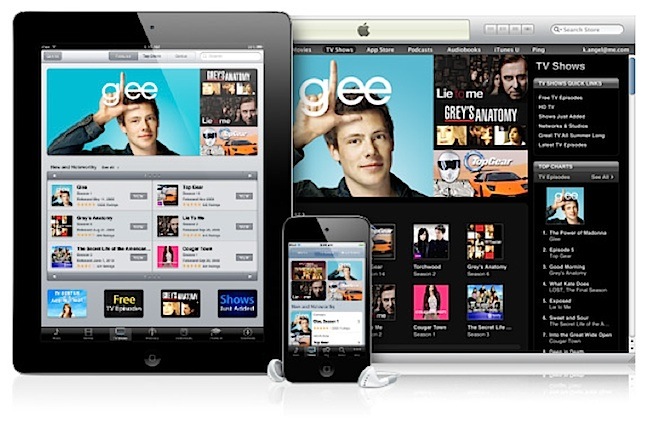
Unlike broadcasting, there is an absence of Internet licences in Australia, the field is wide open for all to broadcast. The latest online entities such as Google, Facebook, Yahoo, YouTube and Twitter were conceived by youthful, technically savvy upstarts, rather than the established media moguls. This has not stopped the moguls from buying into new media, but in a number of cases it has been counter productive. The Warner/CNN/AOL venture soured and the purchase of MySpace by News Corp saw that enterprise lose market prominence.
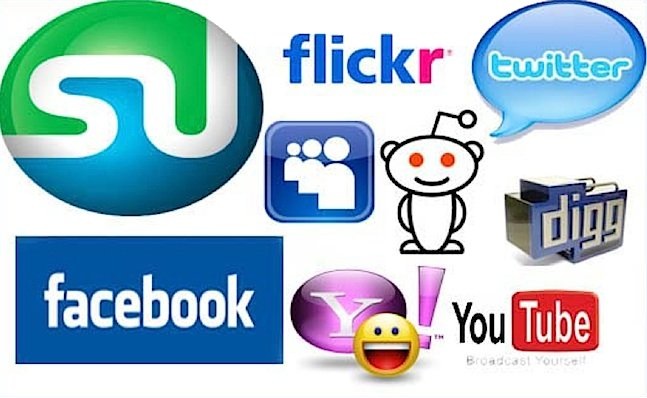
Now one of the most crucial experiments in making an online newspaper viable is being bankrolled by Rupert Murdoch. Though the establishment and running costs are modest by Murdoch standards, the importance of this venture cannot be underestimated. Old media is experiencing an audience decline which will reach critical when the older generations of newspaper readers fade away, for the younger generations exhibit less inclination to follow their forebearers reading habits.
Newspapers are concerned with declining readers and advertising, whilst television has to contend with greater competition from not only free-to-air multiple digital channels and Pay TV, but also the downloading of content, both legal and illegal.

On the assumption that consumers are awaiting the definitive application which combines all media forms into an online newspaper rich in imbedded sound and visual content, and in anticipation of a market developing where people will pay rather than leach news and information content, Rupert Murdoch is employing his newspaper and television resources to seize this perceived opportunity.
Introducing ‘The Daily’
WA TV History
The first daily news, entertainment and sport publication created by News Corporation for the iPad. A pioneering multimedia rich concept from a global vertically integrated company founded by Rupert Murdoch, with properties in film, television, cable, magazines, newspapers and publishing. Designed to generate an online demand for a subscription based publication that is anticipated to replace the traditional ink and paper versions, as new generations increasingly have less need for older forms of media. This also presents greater economies of scale as production and distribution costs are dramatically scaled back.
Rupert Murdoch – Launch of ‘The Daily’
WA TV History
The Daily launched on February 2, 2011 as an iPad based News publication with interactive capabilities. The Daily is offered exclusively in Apple’s iPad App Store and was available free for two weeks. It costs just 99 cents a week, or $39.99 a year.
iPad based ‘The Daily’ Demonstration
WA TV History
Watch The Daily’s official launch event from February 2, 2011, led by Editor-in-Chief Jesse Angelo and Publisher Greg Clayman. Also present was Eddy Cue, vice president of Internet Services from Apple.
Question and Answer session about ‘The Daily’
WA TV History
The Daily launched on February 2, 2011 as an iPad based News publication with interactive capabilities. The Daily is offered exclusively in Apple’s iPad App Store and was available free for two weeks. It costs just 99 cents a week, or $39.99 a year. The panel consists of Rupert Murdoch, Jesse Angelo, Greg Clayman and Eddy Cue.








Thanks Ken,
Have downloaded the app now having missed the hype initially. It seems to have remedied a number of the shortcomings of The Australian’s effort; in particular the ability to share articles. The Oz was a very closed system. The Daily looks very MOR; what does it stand for? Articles are very short. It’s not a serious read.
It’s still predominantly an 80 page newspaper in iPad format; I don’t think there’s any breakthrough thinking so far.
Pages look blurry in carousel view. Some welcome innovation in the game space but still only Sudoku and crosswords. The audio doesn’t seem to allow any navigation; not useful.
AppWatch? Relevant. And a Download It Now button at the foot of every review. Good thinking.
Shuffle feature an interesting browsing alternative but too slow.
The ads are multi-page interactive video (html5?) and very nice they look indeed. Some ads have a Download App button at the bottom of the screen.
At least they’re thinking about using the medium to advantage.